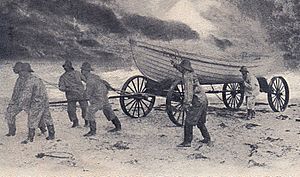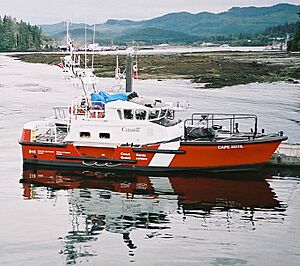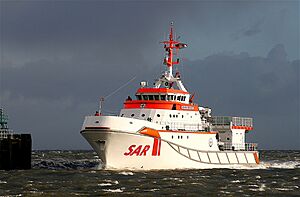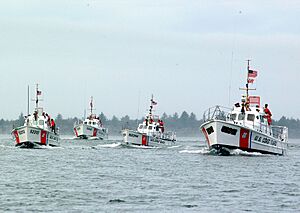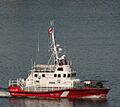Lifeboat (rescue) facts for kids
A rescue lifeboat is a special boat used to help ships or people in trouble on the water. It saves crew and passengers. Lifeboats can be powered by hand, sails, or engines. They can be solid, inflatable, or a mix of both.
Contents
- How Lifeboats Help
- Different Kinds of Rescue Boats
- A Look Back: Lifeboat History
- Modern Lifeboats in Action
- Images for kids
- See also
How Lifeboats Help
There are three main types of rescue boats:
- Inland boats: Used on lakes and rivers.
- Inshore boats: Used closer to the coast.
- Offshore boats: Used in deeper waters further out at sea.
A rescue lifeboat is built with special features. These help it find, rescue, and save people in danger on the sea or other large bodies of water.
In the United Kingdom and Ireland, rescue lifeboats are often run by volunteers. They are designed to be sent out quickly to reach ships or people in trouble. Offshore boats are called 'All-weather' lifeboats. They can travel about 150 nautical miles (280 km) to 250 nautical miles (460 km). Their size affects how well they handle bad weather, how much fuel they carry, and what navigation and communication tools they have.
A larger lifeboat and its crew can work up to 20 nautical miles (37 km) from a safe place. They can stay on scene for several hours to search, with enough fuel to return. They can operate in strong winds and rough seas, day or night. Smaller inshore rescue boats (IRBs) or inshore lifeboats (ILBs) cannot handle these tough conditions for long.
In countries like Canada and the United States, 'motor lifeboat' (MLB) means a rescue boat based on shore. These are usually staffed by full-time coast guard members. They wait on standby, ready to go, much like firefighters. In Canada, some lifeboats have a mix of full-time staff (operator, engineer) and trained volunteers as crew.
Different Kinds of Rescue Boats
Inflatable Boats
Early inflatable boats, like those used by the Royal National Lifeboat Institution (RNLI) in 1963, grew larger. Those over 3 metres (9.8 ft) often had plywood bottoms and were called RIBs (Rigid Inflatable Boats). Newer RIBs have special hulls and inflatable tubes. Small, two-person inflatable rescue boats (IRBs) were later brought back by the New Zealand Lifeguard Service. Other groups, like the RNLI, also adopted them.
Larger Lifeboats
Bigger, non-inflatable boats are also used as lifeboats. The RNLI uses the Severn class lifeboat and Tamar class lifeboat as all-weather lifeboats (ALB). In the United States and Canada, 'motor lifeboat' (MLB) refers to similar non-inflatable boats that can right themselves if they flip over. An example is the 47-foot Motor Lifeboat. In France, the SNSM mainly uses 17.6-meter "Patron Jack Morisseau" class all-weather lifeboats.
In 2022, the Canadian Coast Guard launched 62-foot (19-meter) Bay Class Lifeboats. These boats are based on the design of the shorter RNLI Severn Class All-weather Life-Boat.
A Look Back: Lifeboat History
Early Efforts in China
The first recorded boat rescue attempt happened in China around the second century AD. It was an unsuccessful try to save Qu Yuan from drowning in the Miluo River. Local fishermen tried to help him. This act is remembered every year in the 2,000-year-old dragon boat festival. This festival is a special cultural heritage recognized by UNESCO.
A regular lifeboat service operated from 1854 to 1940 on the middle part of the Chang Jiang, also known as the Yangtze River. This major river flows through central China. These waters were very dangerous for travelers due to narrow gorges and strong currents. The Yangtze was a main way to travel between coastal China (Shanghai) and inland China (Chongqing).
These river lifeboats were usually red and made of wood. They were long and narrow with a shallow bottom. This design helped them move sideways to avoid rocks, much like modern rafts used for fast rivers. People could also pull them upstream along narrow paths next to the river.
Lifeboats in the United Kingdom
The first lifeboat station in Britain was set up at Formby beach in 1776. William Hutchinson, a dock master, started it.
The first non-sinking lifeboat is credited to Lionel Lukin, an Englishman. In 1784, he changed a 20-foot (6.1 m) Norwegian yawl. He added waterproof, cork-filled sections for extra buoyancy and a cast iron keel to keep the boat upright.
The first boat built specifically as a lifeboat was tested on the River Tyne in England on January 29, 1790. Henry Greathead built it. His design won a competition. Greathead's boat, named Original, started service in 1790. Thirty-one more boats of the same design were built. This 28 feet (8.5 m) boat was rowed by up to 12 crew members who wore cork jackets. In 1807, Lukin designed the Frances Ann. This boat saved 300 lives over 42 years.
The first design that could right itself after flipping over was made by William Wouldhave. However, these self-righting designs were not widely used until the 1840s.
These early lifeboats had 6 to 10 volunteers who would row out from shore to help ships in trouble. In the UK, these crews were usually local boatmen. For example, the Newhaven Lifeboat started in 1803 after HMS Brazen wrecked, and only one of 105 crew members was saved. The UK later combined many local efforts into one national group in 1824. This group became the Royal National Lifeboat Institution. An early example was the Landguard Fort Lifeboat from 1821.
In 1851, James Beeching and James Peake created a self-righting lifeboat design. This became the standard model for the new Royal National Lifeboat Institution fleet.
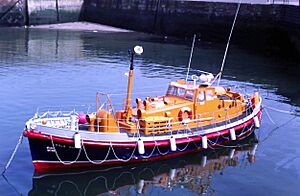
The first lifeboat with an engine, the Duke of Northumberland, was built in 1890. It was powered by steam. In 1929, the motorized lifeboat Princess Mary was launched. It was the largest ocean-going lifeboat at that time. It could carry over 300 people on rescue missions. The Princess Mary was based at Padstow in Cornwall, England.
Lifeboats in the United States
The United States Life Saving Service (USLSS) began in 1848. This was a US government agency that grew from private efforts to save shipwrecked sailors and passengers. In 1915, the USLSS joined with the Revenue Cutter Service to form the United States Coast Guard (USCG).
In 1899, an engine was added to a 34-foot (10 m) lifeboat on Lake Superior, Michigan. This marked the start of the term motor life boat (MLB). By 1909, 44 boats had engines, with power increasing to 40 hp (30 kW).
The sailors of MLBs are called "surfmen". This name comes from the volunteers of the original USLSS. The main school for training USCG surfmen is the National Motor Lifeboat School (NMLBS). It is located at the Coast Guard Station Cape Disappointment at the mouth of the Columbia River. This area has dangerous sand bars, making it a tough training spot for surf lifesavers.
Lifeboats in Canada
Canada started its first lifeboat stations in the mid-to-late 1800s. These were along the Atlantic and Pacific coasts, and on the Canadian side of the Great Lakes. The first organization was called the "Canadian Lifesaving Service."
In 1908, Canada had the first lifeboat in North America to be equipped with a motor. This was a pulling sailing boat design located at Bamfield, British Columbia.
Lifeboats in France
The Société Nationale de Sauvetage en Mer (SNSM) is a French volunteer group. It was formed in 1967 by combining two older organizations. Its job is to save lives at sea around the French coast, including overseas areas.
Modern Lifeboats in Action
Lifeboats have changed a lot since 1890 with the addition of engines. Engines provide more power to get through waves and perform rescues further out. Older lifeboats used sails and oars, which were slower and depended on wind or human strength. Modern lifeboats usually have electronic tools like radios and radar. These help them find people in trouble. They also carry medical supplies and food for survivors.
The Rigid Hulled Inflatable Boat (RHIB) is now considered the best type of boat for inshore rescues. They are less likely to be flipped over by wind or large waves. Special jet rescue boats have also been used successfully. Unlike regular pleasure boats, these small to medium-sized rescue boats often sit very low in the water. This makes it easier to bring victims aboard without lifting. These boats are designed to operate even with water inside their hull. They rely on special flotation tanks to stay afloat and upright.
Inflatable Boats (IBs) became less common after RIBs were introduced in the 1970s. However, in places with large waves like New Zealand, small, non-rigid powered boats called Inflatable Rescue Boats (IRBs) were brought back. They were first used at Piha Beach in New Zealand. Now, many other countries, including Australia and the UK (RNLI), use them.
Lifeboats Around the World
Australasia's Surf Rescues
In Australasia, surf lifesaving clubs use inflatable rescue boats (IRB) for rescues of swimmers and surfers near the shore. These boats are often like the rubber Zodiacs and have a 25-horsepower outboard motor. When not used for rescues, these boats are used in competitive rescue racing.
Many states also have power craft rescue services. RWCs (Rescue Water Craft, or Jet Skis) are common at beaches for lifesaving. New South Wales uses dual-hull fiberglass offshore boats. Queensland, Tasmania, and South Australia use aluminum hull Jet Rescue Boats, about 6 meters long. Some areas, like North Queensland, use RNLI-style rigid hull inflatables.
In Auckland, New Zealand, two 15-foot surf jet rescue boats were stationed in the 1970s and 1980s. They were at Piha Beach, home of the Piha Surf Life Saving Club.
Canadian Coast Guard Boats
The Canadian Coast Guard uses motor lifeboats that are changed versions of RNLI and USCG designs. Examples include the Arun and the 47-footer.
French Sea Rescue (SNSM)
The SNSM in France operates over 500 boats. More than 3200 volunteers staff these boats. They range from all-weather lifeboats to jetskis. These are spread across 218 stations, including 15 in overseas territories. In 2009, the SNSM handled about half of all sea rescue operations in France. They saved 5,400 lives and helped 2140 boats in trouble. The service has 41 all-weather rescue boats, 34 first-class rescue boats, 76 second-class lifeboats, and 20 light rescue boats. All these boats are designed not to sink. They have very light materials injected into the hull. This keeps the boat floating even if it fills with water. They also have sealed compartments. All-weather lifeboats from 15 to 18 meters can right themselves if they flip. The first and second-class boats, which are 14 and 12 meters long, are also self-righting.
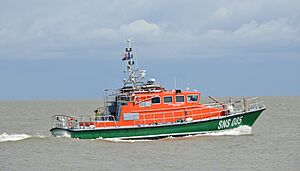
German Sea Rescue (DGzRS)
In Germany, the German Maritime Search and Rescue Service (DGzRS) has provided sea rescue since 1865. It is a non-profit group that relies only on donations, not government money. It has many boats and ships. The biggest is the 46 meters (151 feet) Hermann Marwede. It weighs 400 tons and is the largest lifeboat in the world. It operates from the island of Helgoland. The DGzRS works from 54 stations in the North Sea and the Baltic Sea. It has 20 rescue cruisers, often carrying a smaller rescue boat. These are mostly run by full-time staff. It also has 40 rescue boats run by volunteers.
Volunteer groups like the German Red Cross (Wasserwacht) and DLRG also provide lifeguarding and emergency help for rivers, lakes, and coasts.
Dutch Lifeboat Innovations
The Dutch lifeboat group Koninklijke Nederlandse Redding Maatschappij (KNRM) has created jet-driven RIB lifeboats. They have three classes. The largest is the Arie Visser class. It is 18.80 meters long, has two jets, and two 1,000 hp (750 kW) engines. It can go up to 35 knots (65 km/h) and carry 120 people. Some local lifeguard groups also help with search and rescue.
Most Scandinavian countries also have volunteer lifeboat groups.
UK and Ireland: RNLI and Others
Royal National Lifeboat Institution
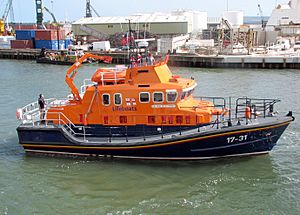
The Royal National Lifeboat Institution (RNLI) has lifeboats around the coasts of Great Britain and Ireland. Most of their crews are unpaid volunteers. Their equipment is paid for by donations.
The RNLI designs and builds several types of all-weather motor lifeboats. These include the Arun class (always afloat), the Tyne class (launched from a slipway), and the Mersey class (launched from a carriage). Newer models like the Trent and Severn classes were introduced in the 1990s. The Tamar class started service in December 2005. The FCB2 class (now called Shannon) was accepted as a proven design on April 11, 2011. This continues the RNLI tradition of naming all-weather lifeboat classes after rivers in the British Isles.
Independent Services
There are at least 70 other lifeboat services in Britain and Ireland. These are separate from the RNLI. They provide lifeboats and crews 24 hours a day, all year. They are staffed by unpaid volunteers. They operate inland, inshore, or offshore, depending on local needs.
United States Coast Guard Lifeboats
The United States Life Saving Service started using motorized lifeboats in 1899. Today, sea rescue in U.S. waters is a duty of the United States Coast Guard. The Coast Guard's MLBs are built to handle the toughest conditions at sea. They are designed to drain water by themselves (self-bailing) and can right themselves if they flip over (self-righting). MLBs are used for surf rescue in bad weather.
Early US Lifeboats (36-foot)
The 36-foot (11 m) Type "T" model was introduced in 1929. It was the main coastal rescue boat for over 30 years. The Coast Guard Yard built 218 of these boats. The last one served until 1987.
Larger US Lifeboats (52-foot)
In the mid-1930s, the USCG ordered two 52-foot wooden-hulled motor lifeboats. These were for busy areas with rough seas. They could rescue about 100 people and tow other boats. These were the only Coast Guard vessels under 65 feet (20 m) that were given names.
A steel-hulled version was introduced in 1956. Four of these 52-foot MLBs were completed by 1961. They remained active until 2021, when they were retired. The Coast Guard is planning a new, larger replacement boat for heavy weather.
The 44-foot Lifeboat
During the 1960s, the Coast Guard replaced the 36-foot (11 m) MLB with the new 44-foot (13 m) boat. These steel-hulled boats were more capable. A total of 110 were built by the Coast Guard Yard. Another 52 were built by the RNLI and others. The last active 44' MLB in the US Coast Guard was retired in May 2009. These boats are still used in other parts of the world.
The 30-foot Surf Rescue Boat
Another surf-capable boat was the 30' surf rescue boat (SRB), introduced in 1983. It could right itself and drain water. It was designed for search and rescue in bad weather, usually with a crew of two. Most of these boats were taken out of service in the late 1990s. One still remains active in Depoe Bay, Oregon.
Modern US Lifeboats (47-foot)
The USCG designed and built new aluminum 47-foot (14 m) lifeboats. The first one was delivered in 1997. The 47-Foot Motor Lifeboat can handle strong impacts and right itself in less than 10 seconds. It can travel at 25 knots (46 km/h). There are 117 of these boats working, with 200 planned for the USCG. Another 27 are being built for the Canadian Coast Guard.
Images for kids
-
Southport lifeboat station, England
-
Inside Southport lifeboat station, England
-
Southport inshore rescue boat on trailer showing special tractor which steers with an articulated front end, which is somewhat wedge-shaped to push obstructions aside
-
One of four refurbished 44-foot patrol boats supplied to the Djibouti Navy
-
Fast rescue boat during the STCW-course of the Alandica Shipping Academy in Åland
See also
 In Spanish: Buque de salvamento y rescate para niños
In Spanish: Buque de salvamento y rescate para niños
- Airborne lifeboat
- Boat
- Convoy rescue ship
- International Maritime Rescue Federation
- James Beeching (1778–1858), inventor of the self-righting lifeboat
- List of RNLI stations
- Muster drill
- Royal National Lifeboat Institution
- Search and Rescue


